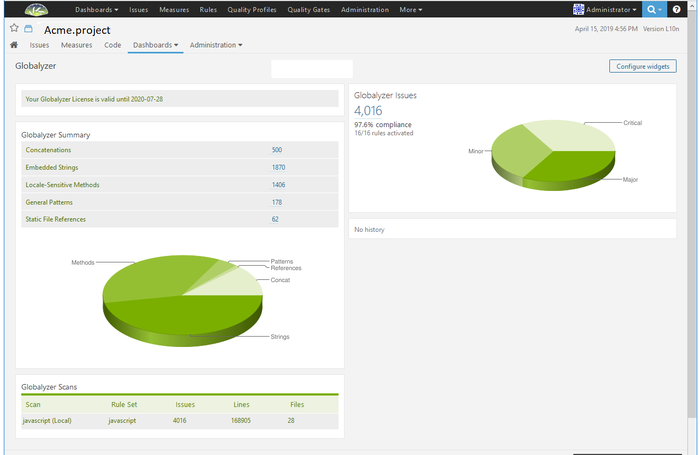Difference between revisions of "Globalyzer CI/CD (Continuous Integration and Continuous Delivery)"
| Line 4: | Line 4: | ||
[[File:GlobalyzerDashboard.png |700px]] |
[[File:GlobalyzerDashboard.png |700px]] |
||
| − | ==How do I install Globalyzer Lite?== |
||
| − | |||
| − | To install the Globalyzer Lite, you first need a Globalyzer account (see [[Globalyzer_Overview_and_General#How_do_I_obtain_a_Globalyzer_account.3F|this FAQ]]). Once you have an account, you log into the Globalyzer Server and at the bottom of your home page there is a link to download Globalyzer Lite. |
||
| − | |||
| − | The Globalyzer Lite is a standalone Java application. It uses Rule Sets to scan code at the command line. It is used in Jenkins configured for the Continuous G11n System and can be integrated as an external tool in an IDE. |
||
| − | |||
| − | Please see [http://www.globalyzer.com/gzserver/home/installclient installation] for complete Globalyzer Lite download/installation instructions. |
||
== Using Globalyzer Lite in a Continuous Globalization System == |
== Using Globalyzer Lite in a Continuous Globalization System == |
||
Revision as of 21:11, 12 June 2019
What is Globalyzer Lite and Globalyzer CI/CD?
Globalyzer Lite is the product created using the Globalyzer API that allows users to scan code and create reports without having to use the Globalyzer Workbench or set up a database. In the Lingoport Continuous Globalization Server, Globalyzer Lite (Globalyzer CI/CD) is an integral part of the process to create reports that are displayed in the Lingoport Dashboard showing the number of internationalization issues detected.
Using Globalyzer Lite in a Continuous Globalization System
If the Lingoport Continuous Globalization System was installed and configured using the Stack Installer or Stack Updater, then Globalyzer Lite has already been integrated into the system.
- Check in a project definition file into source control.
- On-board a Jenkins project for the code base using one of the templates.
- Check the Lingoport Dashboard and verify that the results are shown.
Globalyzer Lite is easy to integrate into Continuous Integration (CI) systems. For instance, using Lite from Jenkins can be done through the following steps:
- Check in a project definition file into source control (or, if you prefer, place one in the Jenkins server's filesystem).
- Run the following from Jenkins' shell:
java -jar globalyzer-lite.jar -f "${WORKSPACE}/GlobalyzerProjectDefinitionFile.xml" --project-path "${WORKSPACE}" --report-path "globalyzer-lite-reports"
- Use the Lingoport Dashboard to display the results from the generated reports.
You may also pass the reports to your own reporting system.
